Introduction
Beyond3D went to CeBit to catch up with the graphics IHV’s to find out what's new and also take a look at some of the solutions available from their partners. Here’s a rundown of the more interesting graphics related elements from CeBit ’05.
ATI
CeBit 2005 for both ATI and NVIDIA were as much about their new chipset announcements than it was about their graphics products, both with announcements for PCI Express platforms for Intel.
On Friday ATI unveiled their Radeon XPRESS 200 for Intel, formerly known as RS400. Fundamentally RS400 is the Intel equivalent of RS480, ATI's DirectX9 integrated graphics platform for AMD, and as such offer similar features to RS480. However, where the AMD platform has its memory controller on the CPU, meaning the integrated graphics doesn't have direct access to it hence ATI gave the HyperMemory option on RS480 motherboards, the traditional chipset nature of the Intel platform does have the memory controller local to the Northbridge and so HyperMemory is not required here as the control and timings of the memory can be tuned for graphics usage. The graphics configuration of RS400 stays the same as RS480, with similar clock speed ranges (circa 300MHz+) however previous expectations were that the performance of RS400's graphics would be a little higher by virtue of the local memory bus - Beyond3D now has a reference board so we will be testing this aspect, and others, in a later article.
Beside the graphics, the RS400 platform offers numerous features that you would expect to find on a modern chipset supporting the Intel LGA775 socket, inclusive of support for all the latest and upcoming CPU specifications such as Multi-Core support, EM64T, XD Bit and up to a 1066 FSB for Pentium Extreme Edition support. The memory controller also supports DDR2 speeds up to 667MHz and the Northbridge has support for up to 20 PCI Express lanes.
ATI are now fairly old hands at making integrated graphics chipsets for the Intel platform, however whilst they have been fairly successful products as integrated notebook platforms rarely have they managed to break into the top tier OEM space with them and it looks like, similarly, they still do not expect to make too much inroads with this platform either and so they have changed tack a little. One of the markets RS400 is being aimed at is as a virtually complete Media Center platform. With integrated graphics and ATI's video decode and HDTV (component) output capabilities the display side is already a known quantity, however coupled with a Theater 550 PRO board there is a full CE quality encode and decode solution.
Following the initial reviews of ATI's RS480 platform, with the codename "Bullhead" boards, ATI's AMD platform has started to generate a name for itself as being a highly capable overclocking board. They is a fact that wasn’t lost on ATI and they have been promoting this aspect of the platform and have now developed a codename "Grouper" RS480 platform, which Sapphire have picked up on. Grouper is a board that is very specifically targeted towards the enthusiast market with even better overclocking potential than Bullhead – where Bullhead was just a 4 layer board, Grouper is a 6 layer PCB. The reference Bullhead boards had many options exposed in their BIOS and with Grouper there will also be plenty of options available for high overclocks – for instance the HyperTransport clocks will increment to 500MHz in the BIOS, and they expect to achieve speeds between 350-400MHz in normal cooling scenarios.
The Grouper board will also be a little more loaded with features such as increased SATA drive support, with SATA2, thanks to Silicon Image controller chips connected through PCI Express, with RAID 0, 1, 0+1 and 5 support, and will be one of the first to support ATI’s SB450 Southbridge which will include Azalia audio capabilities and have improved USB2.0 performance. Note that the Sapphire board also features both a VGA and DVI output which, when coupled with another ATI graphics board in the PCI Express x16 slot, could enable up to 4 simultaneous display outputs as ATI’s SurroundView already supports this many – should boards with 2 x16 connectors become available this raises the possibility of supporting up to 6 displays on a single system with fairly cheap, off the shelf components.
During our meeting with ATI we also heard of one other potential route that ATI may be looking into for future chipsets. At present producing integrated chipsets can be a fairly limiting in many respects as the Northbridge often needs to be tuned to support the graphics, which can have performance limitations elsewhere, and it is fairly costly to remove the graphics core for non-integrated solutions. However, technology solutions such as HyperMemory is beginning to allow a new way of thinking in terms of integrated chipsets such that it raises the potential to remove the need for integrating the graphics directly on to the core. Potentially future integrated chipsets may take the form of a discrete graphics chip that shares the system RAM through communication to the Northbridge via HyperMemory, meaning that only one Northbridge need be created to support both "integrated" and non-integrated graphics solutions. Potentially this is one step closer to the idea of having a socket on the motherboard for a graphics ASIC and this could even possibly be upgraded should there be newer graphics cores released with more capabilities within the lifetime of the chipset.






